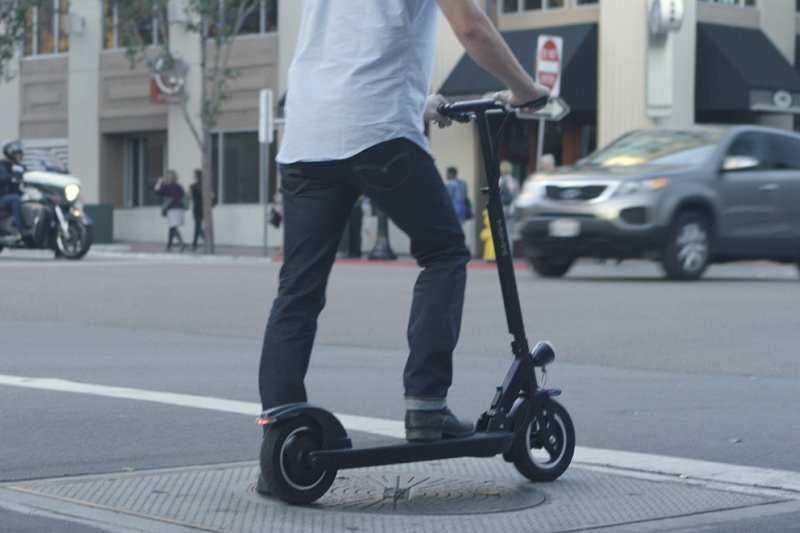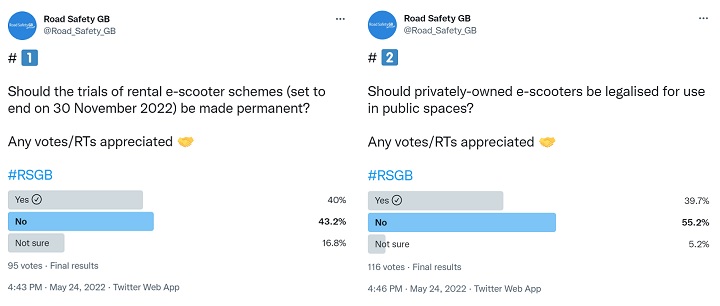
In this latest opinion piece, Edward Seaman, editor of Road Safety News, tackles the controversial and divisive subject of e-scooters – explaining how it is a challenge that the road safety sector must embrace together.
In nearly seven years writing on the road safety newsfeed, rarely (if ever) has a subject piqued my interest quite like e-scooters.
Even away from work, I find myself regularly discussing the topic with friends – often brought about by a compulsion to point out when I see someone illegally riding a privately-owned device in a public place.
Those unfortunate enough to suffer this misfortune are generally surprised to learn that these riders could – in theory – receive a fine and/or points on their driving licence for a whole range of offences (as highlighted by the Met Police).
The confusion comes from the fact they are so prominently advertised in shop windows and online.
But beyond that, interest in what I have to say soon wanes.
Before writing this piece, I decided to carry out two polls on the Road Safety GB Twitter feed, to gauge people’s views on whether the trials of rental e-scooters should be made permanent – and whether their privately owned counterparts should be legalised.

I’m not going to insult anyone’s intelligence by suggesting this amounts to credible research, but it does show opinions on both subjects are somewhat split.
When asked about making trials of rental e-scooter schemes permanent, 43% respondents said no thank you – compared to 40% who said yes please (the rest replied not sure).
The feeling of strength against privately-owned e-scooters was stronger, with 55% against legalisation and 40% in favour. Those with a strong maths brain will realise this also means that the not sure percentage was much smaller than the previous question.
No one needs me to use these polls to tell them that the subject of e-scooters is a divisive one – and I have to be honest and say the journalist in me thrives upon this conflict.
It makes for interesting articles, from both sides of the argument.
That’s not to belittle the safety concerns many have about e-scooters.
Those fears were brought into focus last week, with the Government publishing e-scooter casualty statistics for 2021.
The data shows there were 1,359 casualties in collisions involving e-scooters last year, compared to 484 in 2020.
Sadly, there were nine people killed in collisions involving e-scooters, compared to just one in 2020. All of the fatalities were e-scooter riders.
The full dataset is available via the Government website, including breakdowns by age, gender etc.
I also want to give a nod to the research carried out by PACTS, published last month, which I’m sure most road safety professionals are familiar with.
Throughout 2021, PACTS gathered data of casualties involving e-scooters (riders and other road users) collected from the media, police forces and insurance firms. This included both private and rental e-scooters.
Their data found there were nearly 900 casualties from collisions involving e-scooters in 2021, including 11 deaths.
Meanwhile, it would be wrong to ignore the impact e-scooters have on the safety of blind and partially sighted pedestrians – particularly when they are ridden on pavements.
I have a lot of time for Sarah Gayton from the National Federation of the Blind UK (NFBUK) and the campaigning she does to highlight the issue.
If you haven’t already, I’d encourage you to listen to Sarah’s episode of the RSGB Talk podcast.
But ultimately, it feels like the e-scooter revolution is coming – and therefore the focus should be on ensuring this happens in the safety possible way, as opposed to stopping it from happening.
Earlier this month, the Government announced plans to legalise the use of private e-scooters – while a decision on the future of rental schemes will be made once the trials draw to a close in November.
For the remainder of this article, I’m going to focus predominantly on privately-owned devices – although with rider behaviour, the points largely remain valid for all e-scooter usage.
When it comes to safety, I think the subject can be broken down into two key areas: the rules and regulations (including the build standard of devices) and rider behaviour.
Let’s look at the first issue – starting with the quality of e-scooters themselves. While technically illegal, we know that many people are riding privately-owned e-scooters, and that the standards of these vary greatly.
I’m going to bring it back to the PACTS report, which showed that 18% of the 2021 casualties came from trial e-scooters – and 82% privately-owned e-scooters.
It is worth at this point noting that private e-scooter usage greatly exceeds the numbers used in rental schemes, therefore it would be silly to draw conclusions about relative casualty rates.
But to me this highlights the importance of the build standard – something which the Government appears to understand.
When announcing plans to legalise privately-owned devices, transport secretary Grant Shapps said legislation will focus on allowing the Government to “properly regulate” the standards of e-scooters that can be bought in shops.
He said he wants privately-owned e-scooters to meet similar safety specifications as those involved in rental trials – “potentially even exceeding them”.
This includes safety features such as lighting and indicators.
Other factors that are sure to come under consideration will include maximum speed, wheel sizes and braking devices.
There will also be legislation deciding on how privately-owned e-scooters can be used and these will have safety in mind.
In PACTS’ report, they called for a number of regulations, including:
- Helmet wearing to be mandatory
- Riding on the footway (pavement) or footpath to be prohibited
- Rider age limit of at least 16 years
- Carrying of a passenger to be prohibited
- Drink driving, dangerous or careless riding, and handheld mobile phone use to be prohibited
All these make perfect sense from a safety perspective.
However, the biggest challenge will be encouraging riders to follow them.
I live in Norwich, a city currently hosting one of the myriad of trials. Speaking anecdotally, I regularly see riders carrying passengers and riding on pavements – and dare I say, riding in a dangerous and careless manner.
I completely get why some pedestrians feel terrorised – and it’s an issue that needs addressing.
So how do we do that? The answer is probably a combination of education, training and enforcement.
A publicity campaign highlighting the rules, and consequences of failing to follow them, will be a natural requirement. To this extent, retailers could certainly do more.
Training is also very important – as we need to improve the skills of those riding e-scooters.
There will be questions about how this is delivered. I remember back at the start of the rental trials, a few of the operators attempted to deliver training to riders. Indeed, the subject was covered in another episode of the RSGB Talk podcast, from November 2020, featuring Collette Dunkley from Neuron Mobility.
Will we teach children how to ride e-scooters, in the same way we do cycling?
It is certainly food for thought.
And finally, the can of worms which is enforcement. It is important that offenders fear getting caught – but do police forces have the will, the finances, and the numbers to focus on the issue?
That’s a question which stretches far beyond e-scooters, so I’ll leave you to answer it for yourself.
I feel like I’ve rambled on for long enough, so I’m going to summarise (a bit like Lord Sugar before he fires someone in the Apprentice).
E-scooters are coming (if they aren’t already here). They are going to revolutionise transport in urban settings, particularly in an era where the impact of how we travel on climate change is going to come under even greater scrutiny.
The focus now needs to be on how we ensure their usage is as safe as possible – particularly important in the context of plateauing casualty figures over the last decade.
It is a challenge, but one the road safety industry must embrace together.
Finally, I feel very uncomfortable calling e-scooters ‘devices’. If anyone can come up with a better name, please let me know!
There won’t be proper or effective enforcement. Period.
There will be more deaths and injuries than there were before E-scooters appeared. Period.
Is this worth some unquantifiable benefit related to climate change?
Dave Roberts, NORTH FERRIBY
+5
Helmets are compulsory for all e-scooter riders in Denmark, Spain, Greece, Finland, Cyprus and many more countries …..
David Davies, London
+1
The rental trials have proved that rules and regulations that are in place (such as no riding on pavements or carrying passengers) are impossible to enforce. Edward Seaman refers to “…the can of worms which is enforcement” and he rightly states – “It is important that offenders fear getting caught – but do police forces have the will, the finances, and the numbers to focus on the issue? That’s a question which stretches far beyond e-scooters….”
Just recently within the space of one week – between 9th and 12th May, there have been two more fatalities caused by e-scooters riding illegally on pavements. Jumbo – a 14 year-old Dachshund and Rupert – a 9 month old poodle, were mown down in front of their distraught owners who were walking them along pavements in High Wycombe and Salford. One of the e-scooters involved was reported as being a rented one. RIP Jumbo and Rupert.
I also especially urge people to listen to Sarah Gayton’s episode of the RSGB podcast (see above) which highlights the horrendous dangers caused to sight-impaired people. Likewise people with a wide range of disabilities and the elderly are also affected. The thought of legalisation for private e-scooters fills me with despair.
Christina Young, Liverpool
+7
My observation of 365 illegal e-scooters on roads in Holborn shows that 180 were on the footway, which equates to 49%.
The same anti-social behaviour can be observed regarding the hire e-scooters.
So legalising these is bad news for pedestrians.
How about a levy on sales to fund a dedicated enforcement team?
Richard Thorp Walker, london
+6
Obviously casualties must be related to passenger km for sensible comparison with other modes.
A clear gain in terms of congestion and pollution.
For simplicity treat as bicycles with speeds limited to average cycle speeds . 12 mph?
Compulsory helmets would kill casual rental.
Paul Luton, Teddington
--12